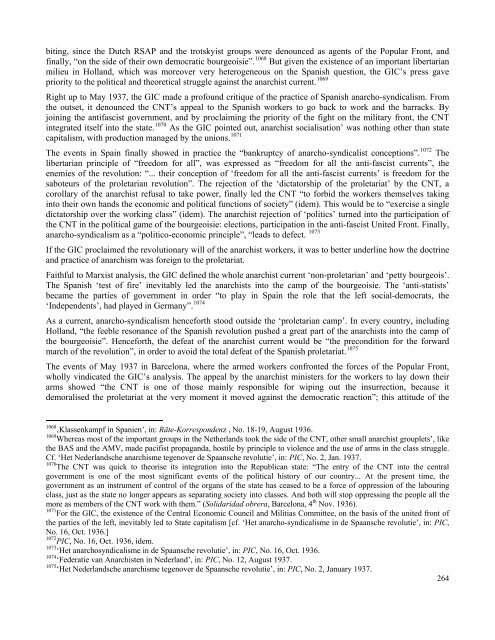The German-Dutch Communist Left - Libcom
The German-Dutch Communist Left - Libcom
The German-Dutch Communist Left - Libcom
Create successful ePaper yourself
Turn your PDF publications into a flip-book with our unique Google optimized e-Paper software.
iting, since the <strong>Dutch</strong> RSAP and the trotskyist groups were denounced as agents of the Popular Front, and<br />
finally, “on the side of their own democratic bourgeoisie”. 1068 But given the existence of an important libertarian<br />
milieu in Holland, which was moreover very heterogeneous on the Spanish question, the GIC’s press gave<br />
priority to the political and theoretical struggle against the anarchist current. 1069<br />
Right up to May 1937, the GIC made a profound critique of the practice of Spanish anarcho-syndicalism. From<br />
the outset, it denounced the CNT’s appeal to the Spanish workers to go back to work and the barracks. By<br />
joining the antifascist government, and by proclaiming the priority of the fight on the military front, the CNT<br />
integrated itself into the state. 1070 As the GIC pointed out, anarchist socialisation’ was nothing other than state<br />
capitalism, with production managed by the unions. 1071<br />
<strong>The</strong> events in Spain finally showed in practice the “bankruptcy of anarcho-syndicalist conceptions”. 1072 <strong>The</strong><br />
libertarian principle of “freedom for all”, was expressed as “freedom for all the anti-fascist currents”, the<br />
enemies of the revolution: “... their conception of ‘freedom for all the anti-fascist currents’ is freedom for the<br />
saboteurs of the proletarian revolution”. <strong>The</strong> rejection of the ‘dictatorship of the proletariat’ by the CNT, a<br />
corollary of the anarchist refusal to take power, finally led the CNT “to forbid the workers themselves taking<br />
into their own hands the economic and political functions of society” (idem). This would be to “exercise a single<br />
dictatorship over the working class” (idem). <strong>The</strong> anarchist rejection of ‘politics’ turned into the participation of<br />
the CNT in the political game of the bourgeoisie: elections, participation in the anti-fascist United Front. Finally,<br />
anarcho-syndicalism as a “politico-economic principle”, “leads to defect. 1073<br />
If the GIC proclaimed the revolutionary will of the anarchist workers, it was to better underline how the doctrine<br />
and practice of anarchism was foreign to the proletariat.<br />
Faithful to Marxist analysis, the GIC defined the whole anarchist current ‘non-proletarian’ and ‘petty bourgeois’.<br />
<strong>The</strong> Spanish ‘test of fire’ inevitably led the anarchists into the camp of the bourgeoisie. <strong>The</strong> ‘anti-statists’<br />
became the parties of government in order “to play in Spain the role that the left social-democrats, the<br />
‘Independents’, had played in <strong>German</strong>y”. 1074<br />
As a current, anarcho-syndicalism henceforth stood outside the ‘proletarian camp’. In every country, including<br />
Holland, “the feeble resonance of the Spanish revolution pushed a great part of the anarchists into the camp of<br />
the bourgeoisie”. Henceforth, the defeat of the anarchist current would be “the precondition for the forward<br />
march of the revolution”, in order to avoid the total defeat of the Spanish proletariat. 1075<br />
<strong>The</strong> events of May 1937 in Barcelona, where the armed workers confronted the forces of the Popular Front,<br />
wholly vindicated the GIC’s analysis. <strong>The</strong> appeal by the anarchist ministers for the workers to lay down their<br />
arms showed “the CNT is one of those mainly responsible for wiping out the insurrection, because it<br />
demoralised the proletariat at the very moment it moved against the democratic reaction”; this attitude of the<br />
1068 ‚Klassenkampf in Spanien’, in: Räte-Korrespondenz , No. 18-19, August 1936.<br />
1069 Whereas most of the important groups in the Netherlands took the side of the CNT, other small anarchist grouplets’, like<br />
the BAS and the AMV, made pacifist propaganda, hostile by principle to violence and the use of arms in the class struggle.<br />
Cf. ‘Het Nederlandsche anarchisme tegenover de Spaansche revolutie’, in: PIC, No. 2, Jan. 1937.<br />
1070 <strong>The</strong> CNT was quick to theorise its integration into the Republican state: “<strong>The</strong> entry of the CNT into the central<br />
government is one of the most significant events of the political history of our country... At the present time, the<br />
government as an instrument of control of the organs of the state has ceased to be a force of oppression of the labouring<br />
class, just as the state no longer appears as separating society into classes. And both will stop oppressing the people all the<br />
more as members of the CNT work with them.” (Solidaridad obrera, Barcelona, 4 th Nov. 1936).<br />
1071 For the GIC, the existence of the Central Economic Council and Militias Committee, on the basis of the united front of<br />
the parties of the left, inevitably led to State capitalism [cf. ‘Het anarcho-syndicalisme in de Spaansche revolutie’, in: PIC,<br />
No. 16, Oct. 1936.]<br />
1072 PIC, No. 16, Oct. 1936, idem.<br />
1073 ‘Het anarchosyndicalisme in de Spaansche revolutie’, in: PIC, No. 16, Oct. 1936.<br />
1074 ‘Federatie van Anarchisten in Nederland’, in: PIC, No. 12, August 1937.<br />
1075 ‘Het Nederlandsche anarchisme tegenover de Spaansche revolutie’, in: PIC, No. 2, January 1937.<br />
264
















